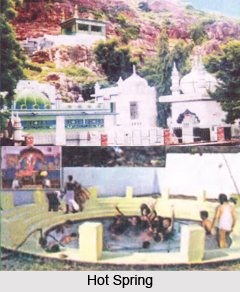 Rajgir is considered a sacred place due to long association with Lord Buddha and Lord Mahavira. It is learned that there were plenty of hot springs in Rajgir earlier. Presently the most visited hot spring is in the eastern slope of Vaibhava Hill. At the foot of Vaibhava Hill, a staircase leads up to various temples. Separate bathing places have been organized for men and women and the water comes through spouts from "Saptdhara", the 7 streams which is believed to find their source behind the "Saptarni Caves", up in the hills. As there are multiple Hindu temple structures and tales related to Mahabharata with the main hot spring, it is very popular among Hindu pilgrims.
Rajgir is considered a sacred place due to long association with Lord Buddha and Lord Mahavira. It is learned that there were plenty of hot springs in Rajgir earlier. Presently the most visited hot spring is in the eastern slope of Vaibhava Hill. At the foot of Vaibhava Hill, a staircase leads up to various temples. Separate bathing places have been organized for men and women and the water comes through spouts from "Saptdhara", the 7 streams which is believed to find their source behind the "Saptarni Caves", up in the hills. As there are multiple Hindu temple structures and tales related to Mahabharata with the main hot spring, it is very popular among Hindu pilgrims.
Brahma Kund in Rajgir
Brahma Kund is the hottest of the springs and the most celebrated with a temperature of 45 degree Celsius. In the western corner of the wall, there is a stone idol of Lord Brahma where the devotees after bathing in the kund make the prescribed rituals. The tank and faucets constructed to facilitate the bathers and there is a separate enclosure with a faucet for ladies. These hot water springs have curative properties, especially for arthritis and joint pains and are sacred to both Hindus and Buddhists.
Makhdum Kund in Rajgir
Makhdum Kund is situated on the north side of the Vipula Hill. A small cave in an upper enclosure is said to have been frequently used by the Makhdum Shah Sharif-ud-Din, a Muslim saint of 14th Century, for purposes of meditation during his sojourn of 12 years in the jungles of Rajgir. The holy water of this kund is warm and sacred for the devotees.
Guru Nanak Kund in Rajgir
At the time of Guru Nanak"s visit, he had long discussion with Buddhist and Jain monks and impressed upon them towards the importance of devotion to one god. The city was surrounded by hot springs and cold drinking water was not available to people. So, on pointing out of the Guru, people dug a place and water gushed out. From then, the place is known as "Nanak Kund", where later this Gurdwara was built.



















